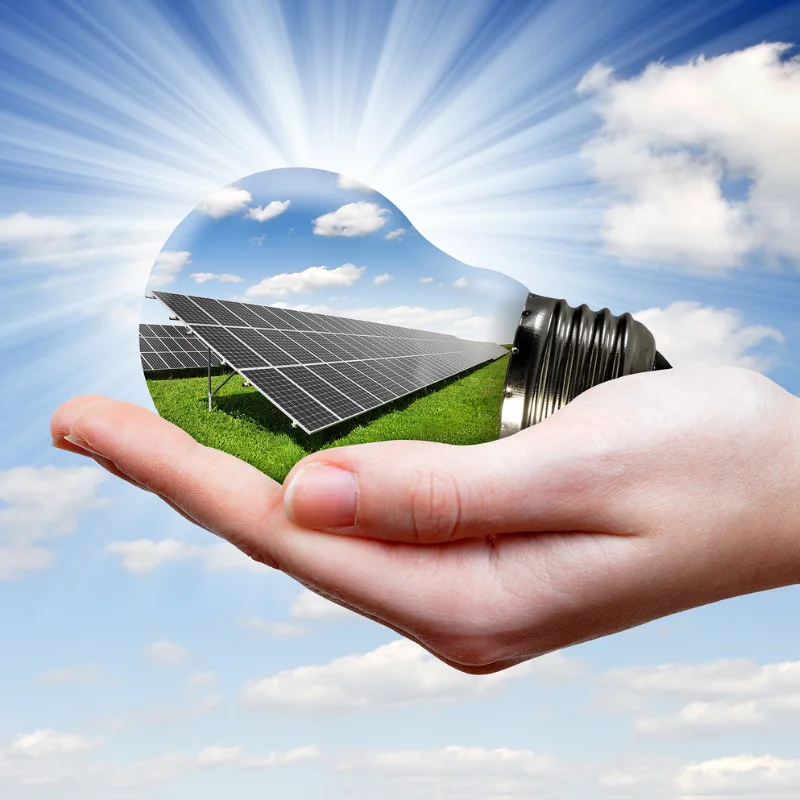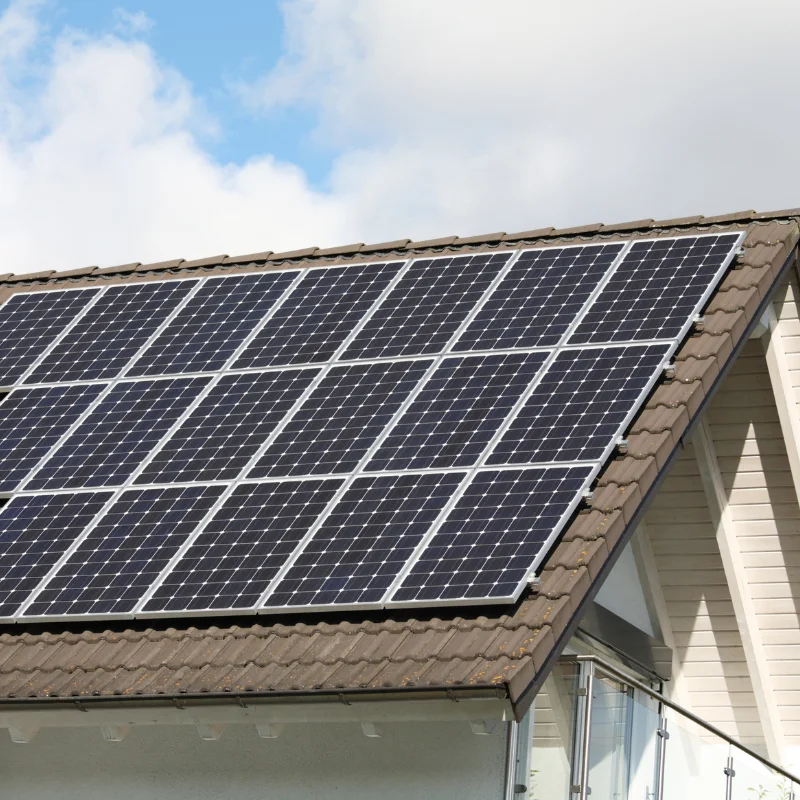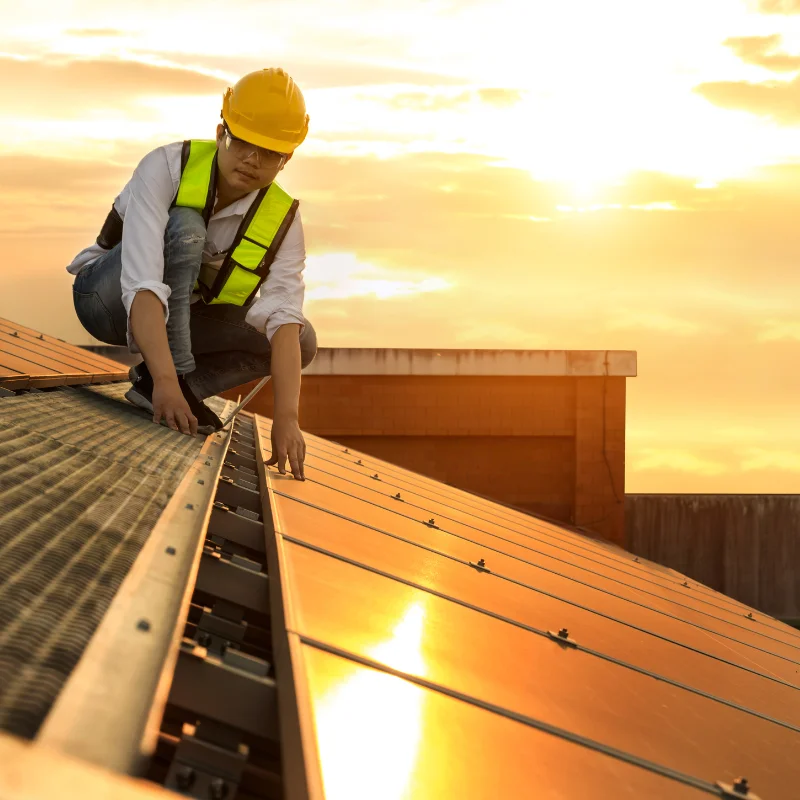This post may contain affiliate links. By browsing this website, you agree to our disclaimer, privacy policy, and terms of use.
Are you intrigued by the idea of going solar, but have no idea where to start? You are not alone! Already, over 4.2 million American homes are equipped with solar panels and live more sustainably.
If you want to adopt a greener lifestyle and save money in the process, this beginner’s guide to solar panels is for you! To help break down the complicated topic of solar energy and how it works, we turned to the experts.
We’ll explain the different types of solar panels, batteries, and inverters on the market, explain why how solar energy is so eco-friendly, and even help you get free solar panels from the government.
I’m no homeowner with a sprawling roof. I live snug as a bug in my cozy city apartment. But that hasn’t stopped me from soaking up the sun’s power for over five years now, thanks to some clever terrace placement of my solar panels.
It might not be the typical solar setup, but hey, it works. In fact, you can even install solar panels on your apartment balcony, if you want.
Contrary to what most beginners believe, you don’t need acres of roof space to tap into the sun’s energy. Whether you’re in a studio or a suburban mansion, you can take advantage of solar energy, the most abundant energy resource on earth, and find the right solar panels for your home.
For this guide to solar panels for beginners, I asked experts in the field of renewable energy and/or solar technology to share their tips and professional opinions.
What is Solar Energy?
To put it simply, solar energy is the energy we get from the sun. It is one of the most common types of renewable energy along with wind energy, geothermal energy, hydropower, ocean energy, and bioenergy. The International Energy Agency (IEA) projects that solar PV will become the largest source of electricity generation by 2035.
So, how does it work? Enter solar panels.
These panels are made up of photovoltaic cells, which are tiny cells that can convert sunlight into electricity. When sunlight hits these cells, they generate an electric current. This electricity can be used to power all sorts of things, from lights and appliances to entire homes.
And, it’s clean. Unlike fossil fuels, which release harmful pollutants when burned, solar energy produces no pollution. So much so that it has managed to save tons of CO2 emissions and 75 million barrels of oil yearly according to IEA. That means cleaner air and a healthier planet for all of us.
How is Solar Energy Converted Into Electricity?
“Solar panels convert sunlight into electricity using photovoltaic (PV) cells. These cells generate a direct current (DC) when exposed to sunlight, which is then converted to alternating current (AC) via an inverter,” Robert Raffa explains
Most of our appliances and devices run on alternating current (AC) electricity. So, to make the electricity from the solar panels usable, it needs to be converted from DC to AC. That’s where the inverter comes in. The inverter takes the DC electricity from the solar panels and converts it into AC electricity that can power your home.

Once the electricity has been converted to AC, it’s ready to use! It flows from the solar panels through the inverter and into your home’s electrical system. From there, it can power all sorts of things, from lights and appliances to computers and TVs.
Raffa pointed out that the efficiency of panels has improved significantly over the years, with top models now approaching 23% efficiency. This basically means that they convert 23% of absorbed sunlight into electricity.
What Are Solar Panels Used For in a Home?
You can use solar panels to charge EV batteries, lighting your home, heating and cooling at room temperature with the help of solar chimneys, and cooking.
In addition to generating electricity for common household tasks, solar panels can be used to heat water as well. The thermal collectors absorb sunlight and transfer heat to water for use in showers and baths.
In fact, solar-powered water heaters can drop your water heating bill by 50% to 80% and are generally 24% to 34% more energy efficient than conventional water heaters, according to the Mr. Rooter Plumbing survey.
Solar panels for the home can also be used as a reliable source of backup power during grid outages or emergencies as well. Excess solar energy generated during the day can be stored for use during periods of low sunlight or high demand.
Can You Run An Entire House On Solar Power Alone?
“In theory, if you’re happy with only consuming power during the day and reducing your consumption to match your solar production on cloudy and rainy days, then yes, you can,” Paul Trad told SKL.
“In reality, however, it’s hard to run an entire house on solar only as we all have nighttime energy consumption. Having a battery can help run your house on solar only by charging during the day and discharging at night but at the current prices, this would be an expensive setup to have,” he explains.
What Are The Benefits Of Solar Panels For Homeowners?
Solar panels have loads of benefits – from energy independence to affordability. Let’s jump into our top 7 benefits of Solar Panels for homeowners!
Energy Independence
With solar panels, you’re not at the mercy of the grid. You’re in control of your own power supply, which means fewer worries about outages or rising energy costs. “Most residential systems are paired with battery storage that can provide power without having to rely on backup power from the grid. “ Jon Bonnar explains.
They are Affordable in The Long Run
Granted, solar panels for beginners are an investment. However, over time, those savings on energy bills really add up, and before you know it, your solar panels have paid for themselves—and then some.
“Although, the amount you save will depend on your usage, the size of your panels, and how much power it can generate. You can sometimes opt for leased solar panels which allows homeowners to host solar panels on their roofs so they can buy the electricity back at a discounted rate, which is less than standard utility providers and means you don’t have to pay the initial cost of installation. “ says Bonnar.
They Run On Clean, Renewable Energy
One of the most important benefits of going solar is reducing your carbon footprint. Solar panels generate electricity without emissions or pollutants, unlike fossil fuels. Burning these fuels releases harmful gases into the atmosphere, like carbon dioxide and methane – both are major contributors to climate change and air pollution.
According to the International Energy Agency, solar PV systems installed in 2020 alone helped to avoid approximately 2.6 billion tonnes of carbon dioxide emissions. That’s equal to removing over 560 million cars off the road for a year.
You Can Take Advantage Of The Government Solar Panels Program
“Having solar panels is increasingly more affordable than ever, especially with the extension of the federal residential solar tax credit. This program allows US taxpayers to claim a 30% tax credit on the cost of solar systems on their income taxes,” Jon Bonnar says.
There are also a variety of solar financing options available in the USA so you pay less money upfront, and the monthly repayment tends to be less than an average utility bill, he added.
Solar panels Are Recyclable
“At the end of its life, most components in a solar panel can be recycled,” Brendan Anderson points out. According to the EPA, glass composes most of the weight of a solar panel (about 75 percent). The rest of the materials list includes an aluminum frame, copper wire, and a plastic junction box.
Solar Panels Boost Your Home’s Value
Who doesn’t love a little boost in property value? Studies conformpanels can actually increase the resale value of your home. Potential buyers love the idea of saving money on energy bills and going green, so having solar panels already installed can make your home more attractive on the market.
They Work in All Climates
You don’t need hot temperatures or bright sunshine for them to work either. Bonnar explains that solar panels will work in winter with limited hours of daylight, even in Alaska where they experience longer, colder winters, as there is still a sufficient amount of power to run the average home.
The US Department of Energy’s Solar Energy Technologies Office (SETO) guarantees that all solar panels perform as best they can, regardless of climate or weather.
Are Solar Panels Environmentally Friendly?
Solar panels are very environmentally friendly.
“In the past, many solar panels weren’t very environmentally friendly, and the manufacturing process was energy-intensive,” says Paul Trad, an engineer with a master’s degree in Photovoltaics and Solar Energy from UNSW.
That’s no longer the case! He explains that today, technology has gotten better, and depending on how and where the panels were made, your energy payback could be as low as 3-4 years and panels last for 20+ years.
Solar panel recycling is also getting better which helps make an even better case for solar technology being and remaining a leader in the renewable space.
Studies have shown that the environmental benefits of solar energy far outweigh these initial costs over the lifetime of the panels.
Unlike fossil fuels such as coal, oil, and natural gas, which emit harmful greenhouse gases and pollutants when burned for energy, solar panels produce electricity without any emissions or pollutants.
Another great thing about solar panels is that they can be installed on rooftops or in open spaces close to where energy is consumed. This basically means that we’re actively reducing the need for long-distance transmission of electricity and minimizing energy losses associated with transmission and distribution.
Types Of Solar Panels For Home Owners, Explained
I think the most common misconception in the solar panel world is that folks think there are just one or maybe two types of solar panels to choose from. Shocker alert! There are 5 amazing solar panel options to choose from.
Monocrystalline Solar Panels
These solar panels are made from single-crystal silicon, giving them a sleek black appearance. “Monocrystalline is the most common but also the most expensive option. That said, it does have the highest average efficiency rating, ranging from 15% to 22%, so they do offer the best long-term benefits,” Jon Bonnar says.
Due to their high efficiency, monocrystalline panels require less space to generate the same amount of electricity as other types of panels. Additionally, they are durable and have a long lifespan, often lasting 25 years or more.
Polycrystalline Solar Panels
Polycrystalline panels are made from multiple silicon crystals, giving them a blue-speckled appearance. While they’re typically less efficient than monocrystalline panels, typically ranging from 13% to 16%, and tend to be more affordable.
Polycrystalline panels are a good option if you have plenty of roof space and want to maximize your budget. Unlike monocrystalline, Polycrystalline panels require more space to generate the same amount of electricity as monocrystalline panels due to their lower efficiency. Despite their affordability, these two can last for close to 25 years.
Thin-Film Solar Panels
Thin-film panels are made from layers of photovoltaic material deposited onto a substrate, such as glass or metal. They’re lighter and more flexible than crystalline panels, making them suitable for unconventional installation methods, such as on curved surfaces or as building-integrated photovoltaics (BIPV).
However, thin-film panels are less efficient than crystalline panels and may require more space to generate the same amount of electricity. Because they have the lowest efficiency rating, ranging from 6% to 12%, they work best for smaller bases where standard panels won’t fit such as with RVs, sheds, and boats.
“As they’re smaller, they involve less labor to install, which reduces installation costs. It’s worth noting however that they aren’t as durable as standard panels and typically only last between 10 and 20 years,” says Jon Bonnar.
There are several types of thin-film technologies, including amorphous silicon (a-Si), cadmium telluride (CdTe), and copper indium gallium selenide (CIGS).
- Amorphous Silicon (a-Si) – efficiency rate 6% to 10%: Made by depositing a thin layer of non-crystalline silicon onto a substrate, these panels are are lightweight and flexible, making them suitable for a variety of applications – portable solar chargers and building-integrated photovoltaics (BIPV).
- Cadmium Telluride (CdTe) – efficiency rate 9% to 18%: These panels are created by depositing thin layers of cadmium telluride onto a substrate and are known for their high efficiency and low cost of production. They are commonly used in large-scale utility projects.
- Copper Indium Gallium Selenide (CIGS) – efficiency rate 10% to 14%: CIGS is manufactured by depositing thin layers of copper, indium, gallium, and selenium onto a substrate. They offer a good balance of efficiency, flexibility, and stability making them ideal for portable solar chargers, building-integrated photovoltaics (BIPV), and other niche applications.
Bifacial Solar Panels
Bifacial panels can capture sunlight from both the front and back sides of the panel, increasing energy production. These panels are created from crystalline silicon and can be mounted on ground-mounted structures or elevated racks to maximize sunlight exposure.
Because they offer increased efficiency compared to traditional monofacial panels, ranging from 15% to 30%, they have higher upfront costs compared to monofacial panels. However, their increased energy production can result in long-term savings.
Solar Shingles
Solar shingles, also known as solar roof tiles, are designed to blend in seamlessly with traditional roofing materials, such as asphalt shingles or slate tiles. These innovative panels serve a dual purpose. Firstly, they provide weather protection and secondly, they offer electricity generation.
While they have lower efficiency rates compared to traditional solar panels, ranging from 10% to 20%, they are more aesthetically pleasing and way less bulky than every other option.

Types of Solar Batteries
Solar batteries provide backup power during grid outages, to make sure that all critical appliances and systems remain intact. For off-grid systems, solar batteries store excess energy generated during the day for use at night or during cloudy periods.
But most importantly, batteries enable homeowners to maximize the use of their solar-generated electricity by storing excess energy for later use, rather than sending it back to the grid.
Here’s a breakdown of the different types of batteries for solar panels for beginners.
Flooded Lead-Acid (FLA) Batteries
These are the most traditional types of rechargeable batteries. They require regular maintenance, including water replenishment and equalization. These batteries are ideal for off-grid solar systems where you want to cut down the cost. While they are pretty affordable, FLA batteries are heavy, less efficient, and require regular maintenance.
Sealed Lead-Acid (SLA) Batteries
These batteries are sealed and require no maintenance. They come in two types: Absorbent Glass Mat (AGM) and Gel. You can use them in both off-grid and grid-tied systems but keep in mind that they are lower efficiency compared to lithium-ion batteries.
Lithium Iron Phosphate (LiFePO4) Batteries
This heavily-used type of lithium-ion battery is ideal for residential solar systems, both grid-tied and off-grid. It has a pretty long lifespan, has high efficiency, is lightweight, and requires low maintenance. However, you should expect higher upfront costs compared to lead-acid batteries.
Lithium Nickel Manganese Cobalt Oxide (NMC) Batteries
Known for high energy density and long lifespan, NMC Batteries are commonly used in electric vehicles and are increasingly popular in home energy storage. Despite their performance, they have certain cons, including cost, and potential concerns over thermal stability.
Types of Solar Inverters
A solar inverter, also known as a PV inverter, is a key component of a solar photovoltaic (PV) system that converts direct current (DC) electricity from solar panels into alternating current (AC) electricity. There are four different types of solar inverters that homeowners can use.
String Inverters
String inverters are the most common type used in residential solar systems. They connect a series, or “string,” of solar panels to a single inverter, which converts the direct current (DC) electricity produced by the panels into alternating current (AC) electricity that can be used by household appliances.
These inverters are best suited for residential and small commercial solar installations where all panels are installed on a single roof plane without shading issues.
The main advantages of string inverters are their cost-effectiveness and relative simplicity in installation and maintenance. However, the performance of the entire system can be affected if one panel’s output drops due to shading or dirt, and there is less flexibility for system expansion.
Microinverters
Microinverters are small inverters attached to each solar panel, converting DC electricity to AC at the panel level. This setup allows each panel to operate independently. Microinverters are ideal for residential systems with complex roof layouts, shading issues, or where maximum system performance and monitoring are desired.
They maximize energy production by optimizing the output of each panel, reduce the impact of shading or individual panel issues, and provide detailed performance monitoring for each panel. The primary drawback of microinverters is their higher initial cost compared to string inverters, and the installation can be more labor-intensive.
Power Optimizers
Power optimizers are devices installed at each solar panel that condition the DC electricity before sending it to a central string inverter for conversion to AC. They are suitable for installations where partial shading or varying panel orientations might affect performance, providing a middle ground between string inverters and microinverters.
Power optimizers enhance system performance similar to microinverters but often at a lower cost and offer detailed panel-level monitoring. However, the system is more complex than a traditional string inverter setup and still requires a central inverter.
Hybrid Inverters
Hybrid inverters, also known as multi-mode inverters, can manage inputs from both solar panels and battery storage systems. They convert DC to AC and can also direct excess solar energy to charge batteries. Hybrid inverters are ideal for homes with solar battery storage, providing flexibility in energy management and backup power during grid outages.
They streamline the integration of solar and battery systems, allowing for efficient energy use and storage management, and can operate in both grid-tied and off-grid modes. The main disadvantage is the higher cost compared to standard string inverters, and they may be more complex to install and configure.
A Beginner Guide To Choosing The Right Solar Panels For The Home
Looking for the best type of solar panel for your specific home needs? This is the ultimate list for you! From the best solar panels for different roof types to house sizes – we have got you covered.
Best Solar Panels For Flat Roof
If you have a flat roof, consider monocrystalline or polycrystalline solar panels. These panels are typically mounted on racks or frames to optimize sunlight exposure. Alternatively, thin-film solar panels may be suitable for flat roofs due to their lightweight and flexible design.
Best Solar Panels For Sloped Roof
For sloped roofs, monocrystalline or polycrystalline solar panels are commonly used. These panels can be installed using roof mounts or racking systems to maximize sunlight capture. Solar shingles may also be an option for sloped roofs, providing a seamless integration with traditional roofing materials.
Best Solar Panels For Small Homes
If you have a small home with limited roof space, consider high-efficiency solar panels, such as monocrystalline panels. These panels can generate more electricity per square meter of space, allowing you to maximize energy production within a smaller footprint.
Best Solar Panels For Large Homes
For larger homes with ample roof space, you have more flexibility in choosing solar panels. Consider factors such as efficiency, cost, and aesthetics when selecting panels that best meet your energy needs and budget.
Best Solar Panels For Low Energy Consumption
If your energy consumption is relatively low, you may not need the highest efficiency panels. You can pick cost-effective options such as polycrystalline panels or thin-film solar panels, which can still provide significant energy savings.
Best Solar Panels For High Energy Consumption
If you have higher energy consumption or want to maximize energy production, opt for high-efficiency solar panels such as monocrystalline or bifacial panels. These panels can generate more electricity, helping to offset higher energy demands.
Most Cost-Effective Options
If budget is a primary consideration, look for affordable solar panel options such as polycrystalline panels or thin-film solar panels. While these panels may have slightly lower efficiency rates, they can still provide substantial energy savings at a lower upfront cost.
Long-Term Investment
If you’re willing to invest more upfront for higher efficiency and performance, consider premium options such as monocrystalline panels or bifacial panels. While these panels may have a higher initial cost, they can offer greater long-term savings through increased energy production and reduced electricity bills.
Expert Tips For Placing A Solar Panel Correctly
- South-facing roofs typically receive the most sunlight throughout the day in the Northern Hemisphere, while north-facing roofs are optimal in the Southern Hemisphere.
- Ideally, solar panels should be installed at an angle that maximizes sunlight exposure, typically between 30 and 45 degrees from horizontal.
- Avoid placing solar panels in shaded areas, such as under trees, nearby buildings, or other obstructions. Even partial shading can significantly reduce the energy output of solar panels.
- Trim trees or remove obstacles that may cast shadows on your solar panels to maximize sunlight exposure.
- Consider the type and condition of your roof when determining solar panel placement. Most solar panels are installed on asphalt shingle, tile, metal, or membrane roofs.
- Make sure that your roof can support the weight of solar panels and that there are no leaks or structural issues that need to be addressed before installation.
- Check local regulations, zoning laws, and homeowners’ association (HOA) rules regarding solar panel installation. Some areas may have restrictions on panel placement, size, or appearance.
- For maximum energy production, consider solar tracker systems that automatically adjust the angle and orientation of solar panels to track the sun’s movement throughout the day.
- Solar tracker systems can increase energy output by up to 25% compared to fixed-tilt systems, but they may require additional space and investment.
Tips For Choosing The Right Battery
- Decide whether you prefer a battery that requires regular maintenance (like flooded lead-acid) or a maintenance-free option (like sealed lead-acid or lithium-ion).
- Check the DoD of the battery, which indicates how much of the battery’s capacity can be used without affecting its lifespan. Higher DoD means more usable capacity.
- Look at the number of charge and discharge cycles the battery can handle before its capacity significantly degrades. A higher cycle life indicates a longer-lasting battery.
- Consider the round-trip efficiency of the battery, which is the percentage of energy that can be retrieved from the battery compared to the energy stored. Higher efficiency means less energy loss.
Tips For Choosing the Right Solar Inverter
- For smaller systems with uniform panel orientation and minimal shading, a string inverter may be sufficient.
- For larger or more complex systems with multiple roof planes or shading issues, microinverters or power optimizers might be better choices.
- String inverters are generally the most cost-effective option, while microinverters and power optimizers are more expensive but can offer better performance in certain conditions.
- If your roof has shading issues or panels face different directions, microinverters or power optimizers can help maximize energy production by allowing each panel to operate independently.
- Microinverters and power optimizers provide detailed, panel-level monitoring, which can be useful for diagnosing performance issues and ensuring optimal system operation.
- If you plan to incorporate battery storage now or in the future, a hybrid inverter can simplify the integration and provide more efficient energy management.
What Solar Financing Options Are Available In The USA?
Worried about the cost of solar panels for the home? Lucky for us, there are amazing financial support options for those of us who choose to add solar panels to our homes! From the federal solar tax credit to solar panel loans and leases – this list is sure to get you started on the right financial foot.
First, What Is The Federal Solar Tax Credit?
A tax credit is a direct reduction in the amount of income tax you owe. For instance, if you claim a $1,000 federal tax credit, it lowers your federal income taxes by $1,000. The federal solar tax credit, also known as the Investment Tax Credit (ITC), allows homeowners to claim a percentage of the cost of a solar PV system on their federal income taxes.
For solar PV systems installed in 2020 and 2021, the tax credit was 26%. In August 2022, Congress extended the ITC to 30% for systems installed between 2022 and 2032. After 2032, the tax credit gradually decreases to 26% in 2033 and 22% in 2034, with the credit expiring in 2035 unless renewed by Congress.
There’s no maximum amount that can be claimed.
Who can qualify according to the IRS?
- Everyone who owns a home located in the United States
- You have to be living in the home – no landlords or other property owners who don’t live in the home.
- Find more on qualifying residences
Solar Panel Loans
With solar panels typically costing everywhere from $3,500 to $35,000, it would be a good idea to check out some of the USA’s best loan options.
These loans work just like every other load, meaning that you can Secured (use your home as borrowing collateral), or Unsecure ( use the product itself as a borrowing collateral). You’ll have to make monthly payments that may be comparable to or lower than your current electricity bills. Interest rates and loan terms vary depending on the lender and borrower’s creditworthiness.
Solar Leases
Solar leases you to “rent” solar panels from a solar provider for a fixed monthly payment. The solar provider owns and maintains the solar panels, while the homeowner benefits from lower electricity bills and potential savings.
You won’t have to pay anything upfront, which is a good solution if you cannot afford to purchase solar panels outright. However, homeowners do not qualify for federal tax credits or other incentives with solar leases.
Power Purchase Agreements (PPAs)
PPAs are similar to solar leases but involve purchasing the electricity generated by solar panels rather than leasing the panels themselves. You basically have to enter into a contract with a solar provider to buy solar electricity at a predetermined rate for a specified period.
There is no upfront cost – just immediate savings on electricity bills. But keep in mind that, again, the lease may not qualify for incentives like federal tax credits.
Property-Assessed Clean Energy (PACE) Financing
PACE financing allows homeowners to finance energy efficiency and renewable energy upgrades, including solar installations, through a special assessment on their property tax bill.
The financing is repaid over time through increased property taxes. PACE has rather flexible terms and may be available to homeowners with lower credit scores. However, eligibility and availability vary by state and local jurisdiction.
Solar Panels For Beginners FAQ
How many solar panels does it take to run a house?
That depends on your household’s energy consumption, location, roof size, and orientation, panel efficiency, and available sunlight. Start by determining your household’s average daily energy consumption in kilowatt-hours (kWh). You can review your utility bills to understand your monthly energy usage or use an online calculator to estimate your energy needs.
Once you have an estimate of your energy consumption and sunlight availability, you can calculate the size of the solar energy system needed to meet your needs. Divide your average daily energy consumption by the average daily sunlight hours in your area to determine the system size in kilowatts (kW).
Finally, based on the system size calculated in step 4 and the wattage of the solar panels (typically ranging from 250 to 400 watts per panel), you can estimate the number of panels required. Divide the system size in kW by the wattage per panel to get the approximate number of panels needed.
P.S. Areas with more sunlight will require fewer solar panels to generate the same amount of energy compared to areas with less sunlight.
How do solar panels work at night?
Solar energy systems can still provide power during nighttime hours through a process called net metering or by using energy storage solutions such as batteries.
Many grid-connected solar energy systems are equipped with net metering capabilities. During the day when solar panels produce excess electricity, it is fed back into the electrical grid, and the homeowner receives credits for the excess power generated.
At night or when solar production is low, the homeowner can draw electricity from the grid, using the credits accumulated during daylight hours to offset the cost of nighttime electricity consumption.
Another option for using solar energy at night is to store excess energy generated during the day in batteries for later use. Solar battery storage systems, such as lithium-ion batteries, store surplus electricity produced by solar panels during daylight hours.
Do solar panels work in cloudy weather and rain?
Yes, solar panels can still generate electricity even on cloudy days or during light rain. : Even when the sun is obscured by clouds, some sunlight still reaches the Earth’s surface.
Solar panels are designed to capture both direct sunlight and diffused sunlight, which is sunlight that has been scattered by clouds, haze, or atmospheric particles. While the energy output may be lower compared to sunny days, solar panels can still generate electricity from diffused sunlight.
They can also generate power even if it’s raining. Rainwater helps to clean dust and debris from the surface of the solar panels, which can actually improve their performance in some cases. However, heavy rain or storms may temporarily reduce energy production due to reduced sunlight exposure and water accumulation on the panel surface.
How long do solar panels last?
The average lifespan of solar panels is 25 to 30 years. However, many solar panels can continue to generate electricity beyond their expected lifespan with proper maintenance and care.
How do solar panels work with your electric bill?
When sunlight is available, solar panels produce electricity, reducing the amount of electricity you need to purchase from your utility company. Many grid-connected solar energy systems are equipped with net metering capabilities.
During periods of excess solar generation, such as sunny days when your solar panels produce more electricity than your home consumes, the surplus energy is fed back into the electrical grid. In return, your utility company credits you for the excess energy exported to the grid.
At times when your solar panels are not producing enough electricity to meet your home’s energy needs, such as during nighttime or cloudy days, you draw electricity from the grid as usual. Your utility company charges you for the electricity consumed, but you can offset these charges with the credits earned through net metering.

In Conclusion: A Beginner’s Guide To Solar Panels For Homeowners
We hope this beginner’s guide to solar panels helped you understand how solar energy works, its benefits, the many different types of panels and equipment, and the solar financing options that are available in the USA.
Solar energy is renewable and sustainable, so it won’t run out and doesn’t harm the environment. What’s more, by generating your own electricity from the sun, you can significantly reduce or even eliminate your monthly electric bills.
Not to mention how many times my solar panels have protected me from power outages. Additionally, many regions offer tax credits, rebates, and incentives that can lower the upfront cost of installing solar panels which is amazing!
Most importantly, using solar energy reduces your carbon footprint. It’s a smart, responsible choice that benefits your wallet, your home, and the planet.






